Jewish History Books for Young Adults: The Holocaust (Page 1) |
If you wish to purchase any of these books, click on either the title or the book cover to be directed to Amazon.com. As a warning, I have put up pictures of the book covers to give you somewhat an idea of the style of each book (I know, I know. "Don't judge a book by its cover") so the pages may load slowly, depending on the speed of your internet connection.
If this page came up without frames, Click here to see the complete website
NOTE: For biographies of individuals associated with the Holocaust (Anne Frank,
Simon Wiesenthal, etc.), go to the
Biographies
For historical fiction books that take place during the Holocaust, go to the
Holocaust Historical Fiction Books Page
For Holocaust books for younger readers, go to the Children's History Page
Other Pages of Interest:
Holocaust History Books For Middle School and Young Adult Readers ...
(Page 1)
(Page 2)
(Page 3)
(Page 4)
(Page 5)
(Page 6)
Holocaust Historical Fiction Books For Middle School and Young Adult Readers ...
(Page 1)
(Page 2)
(Page 3)
(Page 4)
(Page 5)
(Page 6)
Middle School and YA Books ...
Bar Mitzvah Books |
Jewish Fiction |
Historical Fiction |
Torah Study |
Prayer and Jewish Life Books |
Jewish Holidays |
Jewish Biographies |
Jewish History Books |
Holocaust Books for Teens |
Israel Books
Jewish Historical Fiction for Middle School and YA Readers...
Biblical Era |
Middle Ages, Renaissance, and the Spanish Inquisition |
Immigration & The American Experience |
European History |
Holocaust
(Page 1)
(Page 2)
(Page 3)
(Page 4)
(Page 5)
(Page 6) |
Israel
Jewish History Books for Middle School and Young Adult Readers ...
General Jewish History & Nonfiction |
Biblical Era |
European History (Excluding the Holocaust) |
Immigration & The American Experience |
Holocaust |
Israel
Easy Reader and Picture Books ...
Jewish Children's Books (General) |
Jewish Board Books |
Biblical Stories for Children |
Jewish Holiday Books |
Jewish Family Cookbooks |
Folktales and Talmudic Stories for Children |
Jewish Life Books (Mitzvot, Keeping Kosher, etc.) |
Jewish Life Cycle Books |
Family Haggadahs |
Children's Prayerbooks |
Introductory Hebrew Books |
Jewish History and Historical Fiction Picture Books |
Israel Books
And More ...
Jewish Books for Children |
Bar Mitzvah Books |
Jewish Parenting Books |
Hanukkah Books |
Jewish Music for Children |
Jewish Videos |
Jewish Toys and Gifts |
Jewish Gift Baskets and Gourmet Food |
Jewish Jewelry |
Amazon.com Coupons, Promotions, and Sales
NOTE: For biographies of individuals associated with the Holocaust (Anne Frank,
Simon Wiesenthal, etc.), go to the
Biographies
For historical fiction books that take place during the Holocaust, go to the
Holocaust Historical Fiction Books Page
For Holocaust books for younger readers, go to the Children's History Page
Other Pages of Interest:
Holocaust History Books For Middle School and Young Adult Readers ...
(Page 1)
(Page 2)
(Page 3)
(Page 4)
(Page 5)
(Page 6)
Holocaust Historical Fiction Books For Middle School and Young Adult Readers ...
(Page 1)
(Page 2)
(Page 3)
(Page 4)
(Page 5)
(Page 6)
Middle School and YA Books ...
Bar Mitzvah Books |
Jewish Fiction |
Historical Fiction |
Torah Study |
Prayer and Jewish Life Books |
Jewish Holidays |
Jewish Biographies |
Jewish History Books |
Holocaust Books for Teens |
Israel Books
Jewish Historical Fiction for Middle School and YA Readers...
Biblical Era |
Middle Ages, Renaissance, and the Spanish Inquisition |
Immigration & The American Experience |
European History |
Holocaust
(Page 1)
(Page 2)
(Page 3)
(Page 4)
(Page 5)
(Page 6) |
Israel
Jewish History Books for Middle School and Young Adult Readers ...
General Jewish History & Nonfiction |
Biblical Era |
European History (Excluding the Holocaust) |
Immigration & The American Experience |
Holocaust |
Israel
Easy Reader and Picture Books ...
Jewish Children's Books (General) |
Jewish Board Books |
Biblical Stories for Children |
Jewish Holiday Books |
Jewish Family Cookbooks |
Folktales and Talmudic Stories for Children |
Jewish Life Books (Mitzvot, Keeping Kosher, etc.) |
Jewish Life Cycle Books |
Family Haggadahs |
Children's Prayerbooks |
Introductory Hebrew Books |
Jewish History and Historical Fiction Picture Books |
Israel Books
And More ...
Jewish Books for Children |
Bar Mitzvah Books |
Jewish Parenting Books |
Hanukkah Books |
Jewish Music for Children |
Jewish Videos |
Jewish Toys and Gifts |
Jewish Gift Baskets and Gourmet Food |
Jewish Jewelry |
Amazon.com Coupons, Promotions, and Sales
Other Pages of Interest:
Holocaust History Books For Middle School and Young Adult Readers ...
(Page 1)
(Page 2)
(Page 3)
(Page 4)
(Page 5)
(Page 6)
Holocaust Historical Fiction Books For Middle School and Young Adult Readers ...
(Page 1)
(Page 2)
(Page 3)
(Page 4)
(Page 5)
(Page 6)
Middle School and YA Books ...
Bar Mitzvah Books |
Jewish Fiction |
Historical Fiction |
Torah Study |
Prayer and Jewish Life Books |
Jewish Holidays |
Jewish Biographies |
Jewish History Books |
Holocaust Books for Teens |
Israel Books
Jewish Historical Fiction for Middle School and YA Readers...
Biblical Era |
Middle Ages, Renaissance, and the Spanish Inquisition |
Immigration & The American Experience |
European History |
Holocaust
(Page 1)
(Page 2)
(Page 3)
(Page 4)
(Page 5)
(Page 6) |
Israel
Jewish History Books for Middle School and Young Adult Readers ...
General Jewish History & Nonfiction |
Biblical Era |
European History (Excluding the Holocaust) |
Immigration & The American Experience |
Holocaust |
Israel
Easy Reader and Picture Books ...
Jewish Children's Books (General) |
Jewish Board Books |
Biblical Stories for Children |
Jewish Holiday Books |
Jewish Family Cookbooks |
Folktales and Talmudic Stories for Children |
Jewish Life Books (Mitzvot, Keeping Kosher, etc.) |
Jewish Life Cycle Books |
Family Haggadahs |
Children's Prayerbooks |
Introductory Hebrew Books |
Jewish History and Historical Fiction Picture Books |
Israel Books
And More ...
Jewish Books for Children |
Bar Mitzvah Books |
Jewish Parenting Books |
Hanukkah Books |
Jewish Music for Children |
Jewish Videos |
Jewish Toys and Gifts |
Jewish Gift Baskets and Gourmet Food |
Jewish Jewelry |
Amazon.com Coupons, Promotions, and Sales
Holocaust Historical Fiction Books For Middle School and Young Adult Readers ... (Page 1) (Page 2) (Page 3) (Page 4) (Page 5) (Page 6)
Middle School and YA Books ... Bar Mitzvah Books | Jewish Fiction | Historical Fiction | Torah Study | Prayer and Jewish Life Books | Jewish Holidays | Jewish Biographies | Jewish History Books | Holocaust Books for Teens | Israel Books
Jewish Historical Fiction for Middle School and YA Readers... Biblical Era | Middle Ages, Renaissance, and the Spanish Inquisition | Immigration & The American Experience | European History | Holocaust (Page 1) (Page 2) (Page 3) (Page 4) (Page 5) (Page 6) | Israel
Jewish History Books for Middle School and Young Adult Readers ... General Jewish History & Nonfiction | Biblical Era | European History (Excluding the Holocaust) | Immigration & The American Experience | Holocaust | Israel
Easy Reader and Picture Books ... Jewish Children's Books (General) | Jewish Board Books | Biblical Stories for Children | Jewish Holiday Books | Jewish Family Cookbooks | Folktales and Talmudic Stories for Children | Jewish Life Books (Mitzvot, Keeping Kosher, etc.) | Jewish Life Cycle Books | Family Haggadahs | Children's Prayerbooks | Introductory Hebrew Books | Jewish History and Historical Fiction Picture Books | Israel Books
And More ... Jewish Books for Children | Bar Mitzvah Books | Jewish Parenting Books | Hanukkah Books | Jewish Music for Children | Jewish Videos | Jewish Toys and Gifts | Jewish Gift Baskets and Gourmet Food | Jewish Jewelry | Amazon.com Coupons, Promotions, and Sales
 The Diary of a Young Girl : The Definitive Edition Also Available: Paperback Audio Cassette (Narration by Winona Ryder) |
Discovered in the attic in which she spent the last years of her life,
Anne Frank's remarkable diary has since become a world classic -- a powerful
reminder of the horrors of war and an eloquent testament to the human spirit.
In 1942, with Nazis occupying Holland, a thirteen-year-old Jewish girl and her
family fled their home in Amsterdam and went into hiding. For the next two
years, until their whereabouts were betrayed to the Gestapo, they and another
family lived cloistered in the "Secret Annex" of an old office building. Cut
off from the outside world, they faced hunger, boredom, the constant cruelties
of living in confined quarters, and the ever-present threat of discovery and
death. In her diary Anne Frank recorded vivid impressions of her experiences
during this period. By turns thoughtful, moving, and amusing, her account
offers a fascinating commentary on human courage and frailty and a compelling
self-portrait of a sensitive and spirited young woman whose promise was
tragically cut short.
Anne Frank's diaries have always been among the most moving and eloquent documents of the Holocaust. This new edition restores diary entries omitted from the original edition, revealing a new depth to Anne's dreams, irritations, hardships, and passions. Anne emerges as more real, more human, and more vital than ever. If you've never read this remarkable autobiography, do so. If you have read it, you owe it to yourself to read it again. |
 Night By Elie Wiesel |
A terrifying account of the Nazi death camp horror that turns a young Jewish
boy into an agonized witness to the death of his family...the death of his
innocence...and the death of his God. Penetrating and powerful, as personal
as The
Diary Of Anne Frank, Night awakens the shocking memory of evil at
its absolute and carries with it the unforgettable message that this horror
must never be allowed to happen again.
Nobel laureate Elie Wiesel's wrenching attempt to find meaning in the horror of the Holocaust is technically a novel, but it's based so closely on his own experiences in Birkenau, Auschwitz, and Buchenwald that it's generally--and not inaccurately--read as an autobiography. Like Wiesel himself, the protagonist of Night is a scholarly, pious teenager racked with guilt at having survived the genocidal campaign that consumed his family. His memories of the nightmare world of the death camps present him with an intolerable question: how can the God he once so fervently believed in have allowed these monstrous events to occur? There are no easy answers in this harrowing book, which probes life's essential riddles with the lucid anguish only great literature achieves. It marks the crucial first step in Wiesel's lifelong project to bear witness for those who died. |
 The Night Trilogy : Night, Dawn, the Accident By Elie Wiesel |
Wiesel's The Night Trilogy has a different effect to each of its readers. This book is filled with many metaphors and symbolic phrases. Each one being traced back to the death of those who were close to the narrator. The book shifts from the incidents of the Holocaust to other events in the narrator's life.
The overall story takes place during the events of three combined novels. Each unique in its own way, but combined, tell the story of a Holocaust survivor. The novel Night tells the story of a pre-adelescent boy who witnesses life in a ghetto and Holocaust camp first hand. Dawn shows the changes that occur in the narrators life after the Halocaust. His outlook on his life and others changed along with his religion. The Accident depicts the discovery of Wiesel's reason for living. Overall the Trilogy is filled with a sense of the Holocaust and the effects of it on an individual. |
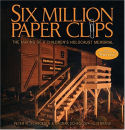 Six Million Paper Clips: The Making Of A Children's Holocaust Memorial By |
To understand the enormity of the Holocaust, students in Whitwell, Tennessee, a town without Jews, began collecting paper clips, one for each victim of the Nazis. German journalists Dagmar and Peter Schroeder, who helped the project garner world-wide attention, retell the exciting story of how a student effort culminated in the creation of the Children's Holocaust memorial, a symbol of tolerance and hope.
|
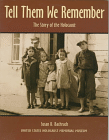 Tell Them We Remember : The Story of the Holocaust |
One and a half million children and teenagers were murdered by the Nazis. This photo-history,
produced in association with the U.S. Holocaust Memorial Museum, focuses on what happened
to young people whose world of family and friends, school and play, was destroyed. More than
30 short, accessible chapters cover the general history, including the rise of Hitler, the ghettos, the
transports, the camps, the gas chambers, and the movements of resistance and rescue. Sidebars
tell the ongoing stories of individual young people and show their ID photos; some of the individuals
are pictured several times during the period 1933-45, but many don't survive. The writing is direct,
with no histrionics or gimmicks. A wealth of material drawn from the museum's large collection of
photographs and taped oral and video histories supports the facts. The systematic murder is
confronted here. We're told of the brutality, the medical experiments, and the corpses stacked up
like cordwood, and there are pictures of the death marches and the gas chambers. The Jews were
the main target of Nazi hatred, but throughout the book, Bachrach also talks about other groups and
individualsincluding Gypsies, homosexuals, and the disabledwho were marked as enemies of the
state. The book's design is clear, with a spacious chronology at the back, a long bibliography,
subdivided by genre and reading level, and an appendix of population figures by country.
This is one of the best books available for introducing the subject to young people and an excellent text for the Holocaust curriculum now required in many states. |
 The Beautiful Days of My Youth : My Six Months in Auschwitz and Plaszow (Edge Books) By Ana Novac |
A brilliant, literary memoir. At the age of 15, Ana Novac (nee Zimra
Harsanyi) recorded these impressions during six harrowing months in
Auschwitz and Plaszow concentration camps, from June to November 1944.
Of the eight camps Ana passed through, she remembers only these two.
She wrote on strips of German propaganda posters torn from the walls
and on sheets of toilet paper. She hid the pages in her shoes and
memorized them when they grew too bulky, summarizing them with a few
key phrases. In each camp, she angled to get the top sleeping platform
to take advantage of the dim ceiling light. Sophie, her camp "sister,"
thought she was crazy, but nevertheless helped her conceal the scraps
of paper. Ana wrote about the horrors, the narrow escapes from death,
the ludicrousness of the situation. She described her camp "family"
in hilariously on target, if "sick," metaphors. She wrote about the
"angel-makers," the women who saved pregnant women from the gas by
aborting their fetuses or by delivering their babies and then disposing
of them. She observed, she thought, she wrote, she existed. Like Gerty
Spies, an older woman who also found her salvation in writing (My Years
in Theresienstadt), Novac's will to write was
stronger than her body's will to die and so she survived. We are
gifted with this work of art, this word tribute to the human spirit.
This memoir of the Holocaust is remarkable on at least two counts: the high caliber of its prose, and its extraordinary provenance as a document originally drafted in Auschwitz and other concentration camps. Acerbic and absorbing, the observations here have a rare and chilling potency. The author, from a Jewish family in Northern Transylvania, was arrested in May, 1944, when she was almost 15; what she describes in her foreword as a "benign amnesia" has erased her memories of arrival in Auschwitz. Once there, however, she miraculously found a pencil stub and devised writing paper, and began recording her experiences. (Endnotes document other diaries and manuscripts by concentration camp prisoners.) She preserved what remains of her diary by various means: she hid scraps of it in her shoes and those of her friends, and at one point, in the Plaszow work camp, she arranged to have a portion of it smuggled out by a freed Polish prisoner. Novac, who recently retranslated her diary from its Hungarian original to French, writes with a shrewd and practiced eye, aiming to create a chronicle of use to others even as she avoids self-consciousness or stiffness in her role as journalist. She girds herself in irony, and her caustic tones seem both to reflect the extreme harshness of her surroundings and to represent the detachment she needed in order to survive. Describing the general reaction to the announcement that girls who volunteer for a "selection" will be brought to a rest camp, she observes, "Here, someone has always seen everything (with her own eyes), and there's always someone to swear to it. Someone already saw the white bread, the new clothes waiting for us, and the toothbrushes..." She sketches prisoners and kapos with merciless clarity, characterizing them with a few vigorous sentences, and unforgettably capturing the current of tensions that continually sweep through the barracks. There are no special concessions here to YA readers (beyond, perhaps, the inclusion of a glossary and explanatory endnotes), nor anything particularly "young" about the material. It would be a shame for the YA classification to limit this book's audienceit deserves the attention of any reader who wishes to understand life, death and survival in Hitler's camps. |
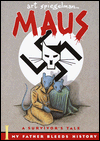 Maus: A Survivor's Tale Volume 1: My Father Bleeds History 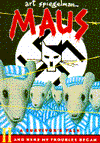 Maus: A Survivor's Tale Volume 2: And Here My Troubles Began |
Awards:
Told with chilling realism in an unusual comic-book format, this is more than a tale of surviving the Holocaust. Spiegelman relates the effect of those events on the survivors' later years and upon the lives of the following generation. Each scene opens at the elder Spiegelman's home in Rego Park, N.Y. Art, who was born after the war, is visiting his father, Vladek, to record his experiences in Nazi-occupied Poland. The Nazis, portrayed as cats, gradually introduce increasingly repressive measures, until the Jews, drawn as mice, are systematically hunted and herded toward the Final Solution. Vladek saves himself and his wife by a combination of luck and wits, all the time enduring the torment of hunted outcast. The other theme of this book is Art's troubled adjustment to life as he, too, bears the burden of his parents' experiences. This is a complex book. It relates events which young adults, as the future architects of society, must confront, and their interest is sure to be caught by the skillful graphics and suspenseful unfolding of the story. |
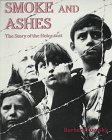 Smoke and Ashes : The Story of the Holocaust By Barbara Rogasky |
Rogasky's graphic and moving chronicle of 20th-Century genocide in the western world tackles enormous questions of ethics, values, and history. She begins with an analysis of the roots of anti-Semitism, and sketches in how Hitler came to power. Then Rogasky details the dark horror of Nazismfrom the beginning pogroms the Nazis organized against German Jews to the setting up of concentration camps and death factories. She utilizes many primary sourcespersonal narratives of victims and survivors and the records left by the Nazisto tell the story of mass murder. In clear and simple prose, she relates how the Jews lived and died in the camps, how they fought and prayed, how a few escaped, and how a small number of non-Jews helped them in their struggle. She concludes with an account of the Nuremburg Trials and the many instances of contemporary anti-Semitism that have outlived Hitler. Black-and-white photosmany of them vivid reminders of the genocideunderscore the dark events described. Milton Meltzer's Never to Forget (Harper, 1976) remains the best narrative account of the Holocaust for older children and teenagers, but because of the pictures here and the accessibility of Rogasky's text, Smoke and Ashes is highly recommended. One Holocaust survivor stated, "There is only one thing worse than Auschwitz itself, and that is if the world forgets there was such a place." Young readers of this book won't forget.
Aided by a powerful collection of photographs--most of them taken by the Nazi SS and German newspaper photographers--Ms. Rogasky tells the story without dramatizing, moralizing, sensationalizing or even judging. She gives her young readers the facts and lets them draw their own conclusions. She asks all the tough questions: How did it happen? Why didn't Jews fight back? . . . Were the Nazis punished for their crimes? And, is the Holocaust a unique event in history? There are, of course, no easy answers. . . . 'The story cannot be made pretty,' Ms. Rogasky writes, 'like a tale told to little children. Thereis no happy ending.' She adds: 'This book was not written to give you nightmares. But it is about the time that a nightmare came true.' |
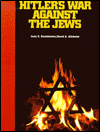 Hitler's War Against the Jews : A Young Reader's Version of Lucy S. Dawidowicz's The War Against the Jews, 1933-1945 By David A. Altshuler and Lucy S. Dawidowicz |
A young reader's version of
The
War Against the Jews: 1933-1945,
Lucy S. Davidowicz's monumental bestseller. Discusses the growth of
anti-Semitism in Germany from the sixteenth century until the Holocaust
during the twentieth century. When the realities of the Holocaust
begin to take shape in their minds, young people confront troubling questions.
Here are the most definitive answers that can be found in print. Illustrated
with historical photographs. Includes topics for discussion.
This books is a good historical treatment for middle school students. The first half of the book tells about Hitler and the German extermination of the Jews and the second half tell the Jews' side of the story. Black and white pictures are plentiful with one every few pages. Kids will understand how prevalent anti-Semitism was when they see the picture of a game board for "Jews Get Out," a board game sold in Germany in 1939 and 1940. |
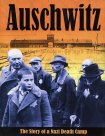 Auschwitz: Story of a Nazi Death Camp By Clive A. Lawton |
During World War II, the abandoned army barracks in Oswiecim, Poland, was transformed into a Nazi death camp. Today, Oswiecim is best known by its German name: Auschwitz. Over 1.5 million people were killed at the camps at Auschwitz. Some were sent to their deaths immediately upon their arrival. Some were condemned to a slower, living death of slave labor. Some were the victims of gruesome medical experiments. How did a sleepy army barracks become the Auschwitz death camp? Who helped in its transformation? And whose lives were destroyed by it? Through first-person narratives, photographs, and expert storytelling, Clive A. Lawton traces the history of a Nazi death camp, and gives readers a glimpse of those who created and operated Auschwitz -- and of the men and women who met their deaths there.
The organization, format, and style of this book are well suited to its audience. Two-page chapters consist of succinctly written summaries of topics; boxed statistics or survivors' accounts are often included, as are maps and captioned photographs, arranged in a collagelike fashion. The material is treated chronologically, from the identification of Oswiecim as a rather pleasant-looking, pre-war Polish town to its transformation by the Germans into the death camp Auschwitz. Chapters discuss Nazi anti-Semitism; the planning, building, and organization of the camp; prisoner transport; the selection process; disposal of bodies; slave labor; medical experiments; and more-a true "guided tour of Hell" to use Francine Prose's phrase. Final chapters cover liberation, Holocaust denial, and the controversies surrounding Auschwitz today. Color and graphic design are used to highlight and show contrast and, as importantly, to mute some of the more horrendous photographed scenes. Students who are not ready for longer or more in-depth books about the Holocaust will learn much about it from this excellent account. In a stirring, large-size photo-essay, facts, pictures, and personal quotes document the history of the Nazi death camp where more than 1.5 million women, men, and children were murdered. Each double-page spread focuses on one aspect of the genocide, from the transports and the selection process to the slave labor, the burning of bodies, and, finally, what the liberators found when they got to the camps. Facsimiles of Nazi documents show plans and projected numbers for extermination. There are images of prisoners' possessions, including a mountain of human hair, but it's the individual faces that personalize the unimaginable statistics. The text is quiet and direct about what happened and how the perpetrators justified it. For some reason, though, the many non-Jewish victims are barely mentioned. A glossary, a time line, and compelling notes on the sources of the photos are provided. Suggest this for discussion in the high-school Holocaust curriculum, and use it with personal accounts such as Primo Levi's Survival in Auschwitz and Elie Wiesel's Night. For adults, too. The name of Auschwitz has become synonymous with the Holocaust and so it is fitting that an entire volume be devoted to describing what happened there. Scrupulously documented, this is short, but packs a lot of information. For this subject, a picture really is worth a thousand words and Lawton carefully lays out the evidence as if with an eye towards the deniers, about which a chapter is included. He uses only the most conservative estimates for the number of people killed at Auschwitz and explains how it is that estimates can be made when the bodies of the victims were burned to smoke and ash and the Germans took such pains to destroy the evidence. Each two-page spread has its own chapter heading, among them "The Transports," "The Gas Chambers," and "Burning the Bodies." A well laid-out combination of text, archival photographs, maps, diagrams of the camp, and survivor testimony provides a many-faceted perspective. Lawton succeeds in conveying the single-minded, machine-like efficiency with which the Germans approached the "final solution" for the "Jewish problem." Disturbing photographs are included-as they must be if the truth is to be told-of piles of dead bodies, a skeletal girl who was a victim of medical experimentation, naked, emaciated men whose private parts are hidden by text, and an inmate who threw himself against the electric fence, a suicide. The jacket-cover text notes that ordinary people helped carry out the evil perpetrated at Auschwitz and asks: "How did it happen?" While Auschwitz doesn't answer the question of how this could happen, it certainly captures the horror of what did happen. Gut-wrenching, this will be invaluable to anyone seeking to educate children andyoung adults. |
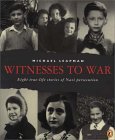 Witnesses to War: Eight True-Life Stories of Nazi Persecution by Michael Leapman |
For millions of children, living in Europe during World War II was a terrifying experience. This book tells the true stories of eight of those children. Each tale is different-living in the Warsaw Ghetto, being sent to concentration camps, being selected for "Germanization"-but each represents the story of millions of other innocent victims whose lives were cut short or changed irrevocably by the Holocaust.
The author relates eight engrossing accounts of children persecuted during the holocaust, including the famous story of Anne Frank. Examples of some of the riveting stories include a girl shipped out of Germany by desperate parents on the Kindertransporte-the children's transport; a boy-one of thousands-kidnapped from his Polish home and sent away to be "Germanized;" and the Czech village of Lidice, which was leveled, all the men massacred, and only 17 of the village's 105 children have ever been traced. Besides the millions of Jews who lost their lives during World War II, a half million Gypsies were murdered in Europe. The courage of children in the face of a world gone mad is inspiring. Time and again the young reader will remind himself that he is not reading fiction. Well-drawn maps and photographs, including "then and now" pictures of surviving children, help make this a moving and unforgettable book. In most cases, the author has interviewed the survivor. Leapman's introduction offers a succinct explanation of conditions in Germany during Hitler's rise to power, one that every child should read, and most adults as well. A book filled with black-and-white photographs that express the incomprehensible horror of war and its effect on children. One photo shows a young child standing with a group of boys. While they look forward, holding their few belongings, emotionless, he is crying and his face is turned away from the Nazi officer standing before them. The caption reads, simply, "Czech children selected for `Germanization.'" More than any movie or play or book of atrocities, this image captures the nightmare of Nazi Germany. In his serviceable text, Leapman presents eight compelling accounts. Each one tells the story of a child from a different area of Europe. Most of the names are unfamiliar: gypsies held at Auschwitz, Jewish girls hidden in a French convent, the children of German Jews shipped to London for their own safety. The book ends with a look at "The Legacy of Anne Frank." An essential title for anyone studying this black period in our history. During World War II, millions were persecuted under Adolf Hitler's plan for creating a master race. Leapman introduces the reader to Hitler's theories and rise to power, conditions in Nazi-occupied countries, and the lives of eight children who belonged to ethnic groups under persecution. Leapman profiles seven children who survived the war. These survivors had different experiences due to financial status, geographical location, and varying cultural and ethnic identities. Children were separated from their parents due to capture or survival tactics. Kindertransporte was a means of relocating children to England. Some Jewish children changed their identities and hid in convents and boarding schools. Slavic and Polish children were often sent to camps and examined. If they possessed enough German traits, they were reeducated and Germanized for adoption with German families or service in the German army. Other children hid from the Nazis and survived after capture as best as possible. The last chapter introduces the story of Anne Frank. Although Anne died in Bergen-Belsen, her diary revealed her life in hiding. Leapman presents an authoritative, informative, and attractive work. His information comes from prior research and personal interviews with seven of the subjects. Maps document the areas under discussion in each chapter, and the author includes photographs from the period that depict acts of the war, persons under persecution, and the subjects of the chapters. The narrative is riveting. The horrific nature of the historical events may trouble some readers, but the author does not include overly graphic depictions of death in the text or photographs. Because the author is British, his references to monetary units may need explaining to students. This is an excellent work that shows the courage of children surviving war, often without the comfort and protection of their parents. Many thousands of children in Europe during World War II were stolen from their parents, screened in racial tests, and then selected for "Germanization" and adoption by German families; many never saw their parents again. Their experiences make up a significant part of this powerful collective biography, written without sensationalism by a British journalist who directed a BBC film about the Nazis' selective breeding program. Also included is a harrowing story, one that is seldom told, about a Gypsy child in Auschwitz. Then there is the boy from Lidice, the Czech town where all the men and most of the children were massacred by the Nazis. Each chapter begins with general historical background and then describes what happened to one child, often based on Leapman's interview with the adult survivor. Some of the other chapters--about children in hiding, and about those on the Kindertransport--will be more familiar from other Holocaust memoirs. Their painful stories show that even for those who found their families after the war, the reunion was sometimes difficult, as in the case of the Jewish child who did not want to give up the faith of the Catholics who had kept her safe. Unfortunately, the book's typeface is small and cramped, with almost no margins, but black-and-white photos document the gripping text, and the family snapshots break your heart. Leapman, a British journalist, suggests the far reaches of Nazi terror by focusing on the experiences of eight children, each victimized during WWII. Anne Frank is here; so is Renee Roth-Hano, whose own book Touch Wood has already described her experiences as a Jewish girl hidden in a French convent. Another Jewish girl escapes Germany through the Kindertransport; a Jewish girl from Paris finds safety in the village of Le Chambon; other children narrowly escape the Warsaw ghetto. These subjects have been more solidly treated elsewhere (for example, the chapter involving Le Chambon does not indicate the heroic scope of its rescue mission nor name the pastors famously responsible for it). But this book is worthwhile nonetheless. A generous supply of unusually well-researched photos amplifies even the more familiar sections, conferring on them a chilling immediacy. Leapman also includes material rarely presented for this age group. He describes the sinister workings of a program that kidnapped Polish children for adoption by proper German families; elsewhere, he traces the fates of the children of Lidice, the Czech village razed to retaliate for the assassination of Reinhardt Heydrich. While this book lacks the emotional charge of a work like No Pretty Pictures, it has firm educational value. |
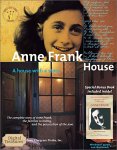 Anne Frank House (CD-ROM) |
Explore the house in Amsterdam where Anne Frank wrote her diary.
This CD-ROM was produced in cooperation with the Anne Frank
Museum and designed for both students and adults
Includes the book The Diary of a Young Girl: the Definitive Edition Visit het achterhuis on the Prinsengracht in Amsterdam and explore the annex where Anne Frank wrote her renowned diary. With more than 1,000 historical photos, over 15 video films, and four hours of spoken text, Anne Frank House presents a complete picture of all the details Anne sought to capture in her diary. The software even includes a copy of Anne's diary, complete with 30 percent more material than the original published version. Install the application and within minutes you'll have access to not only the program, but the Anne Frank Web site as well. The software is set up to resemble the actual house where Anne and her family hid during World War II. Using the mouse, we were able to navigate our way through different rooms throughout the building, as well as other buildings in the surrounding area. The program does an amazing job of capturing the neighborhood in which the family hid for all those years, as well as the actual rooms and corridors of their secret annex. Aside from a virtual tour of the house, complete with posters on the wall and food on the table, the program comes complete with dozens of short stories and explanations about the lives of all the occupants of 123 Prinsengracht. Click on the revolving cube that sits in the lower left-hand corner of your screen and choose from a number of options, including Timelines, People, Hidden Places, and more. We especially appreciated the outline of a typical day in the annex, where clicking on a particular time would launch a detailed explanation of what went on in the house at that particular hour. While the program may seem a bit overwhelming at times, mainly because of the large scope of information offered, it just takes a little time and practice to adjust to the application. In addition, a helpful lost-and-found navigation feature makes it easy to move around the software without losing your bearings. However, we found that sometimes the best way to experience this type of program is simply to point and click and see where it takes you. And if you do get stumped on a term or expression, the comprehensive glossary and help section is usually accessible from wherever you may be in the application. Designed for both students and teachers, Anne Frank House takes a comprehensive yet sensitive look at the complete story of Anne Frank, the families in hiding, and the vast, sometimes incomprehensible war that unfolded before their very eyes. |